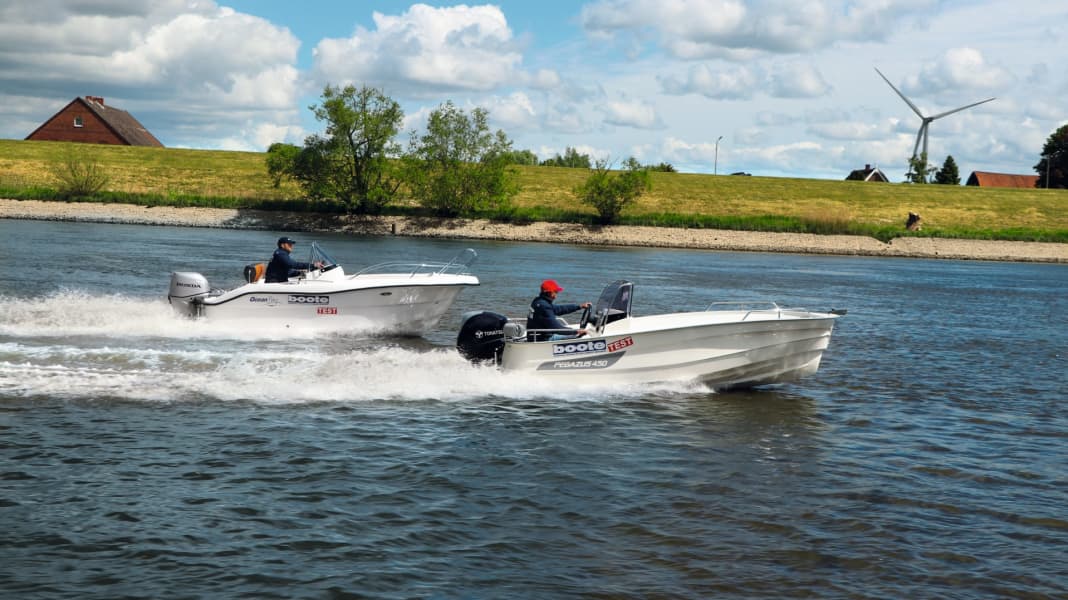
If you're a beginner looking for your first new boat, you might not even think to look around the DIY store or boat chandlery. However, both Bauhaus and the accessories dealer A.W. Niemeyer have console boats in their range which, with their manageable size but sporty motorisation, are above all one thing: a lot of fun! Reason enough to test them.
The fun starts with the purchase, because both the OceanBay MM-450 and the Pegazus 450 are more than affordable: without an engine but with a steering console, the AWN console boat is available from just 6990 euros, and even with a small slip cabin for an extra 1000 euros. The basic version of the Bauhaus boat costs just 2990 euros, with an optional steering position 1150 euros more. This is an attractive start for people on a tight budget, as all other expansion stages (cockpit boxes, railing, cushions, tarpaulin, biminitop, etc.) can be retrofitted at a later date. We have developed the modular design as part of a eight-part series at boote TV on YouTube accompanied.
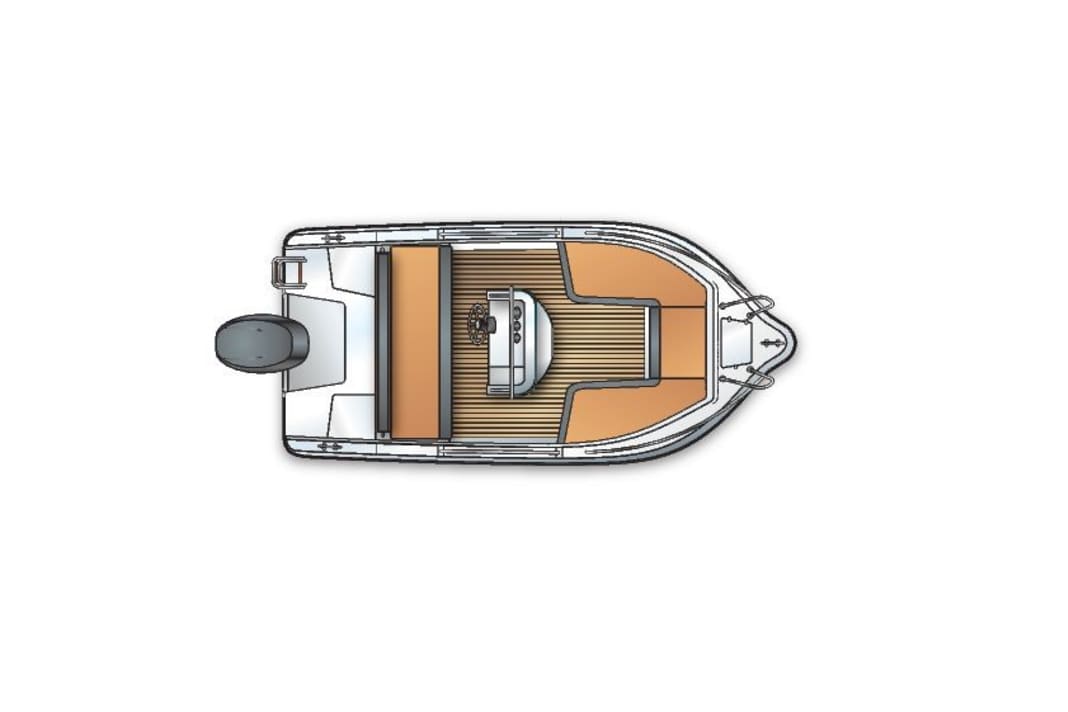





The new owner also has many options when choosing an engine for both boats, from a licence-free 15 hp to a sporty and dynamic 50 hp (Bauhaus) or 60 hp (AWN), which unleash the full potential of each boat. The boats are roughly the same length, but the OceanBay with its self-draining cockpit sits much higher in the water and also appears much more voluminous thanks to its 24 centimetre extra width.
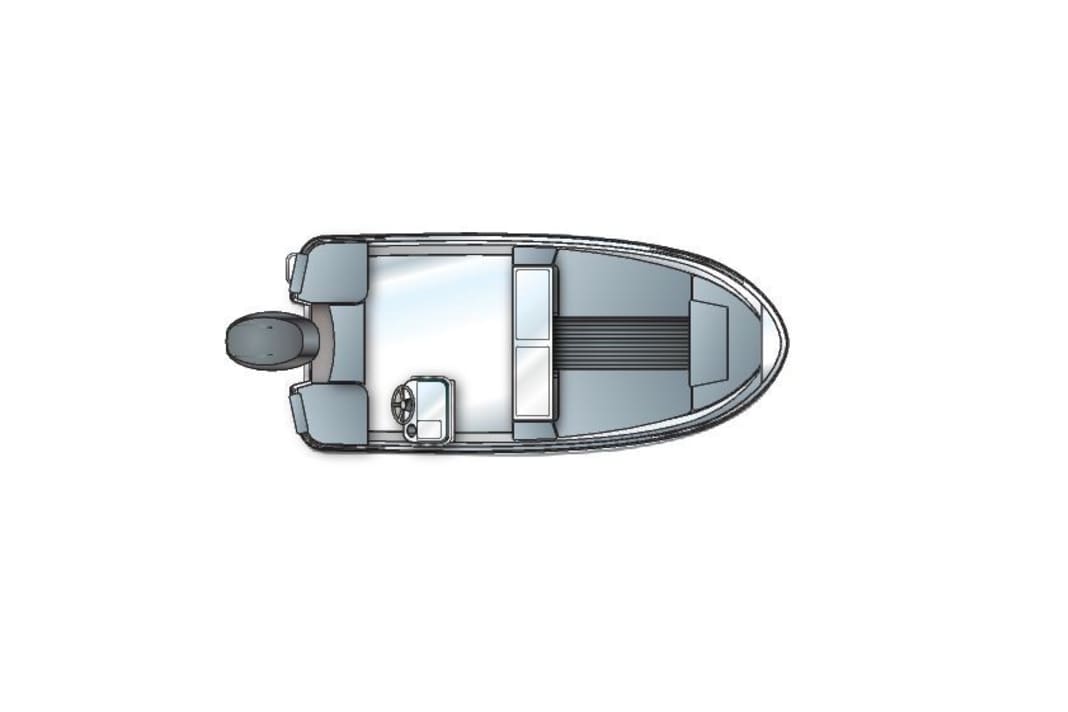





Equipment and processing
Both boats impress with their good manufacturing quality. Even areas that are difficult to see are perfectly sprayed with topcoat. On the Pegazus, even the sawn GRP parts are meticulously sanded and rounded. The installation of the controls and electrics of the Pegazus is the responsibility of the BOOTE crew and can therefore not be assessed. The OceanBay was completed in the shipyard and there is little to criticise. At most in the arrangement of some elements: The switch panel is mounted exactly at knee height, and you inevitably press the toggle switches while driving. The special colour of the upholstery (€280 surcharge) and the synthetic teak covering (€695) give the OceanBay a slightly higher quality appearance than the Pegazus, while the wide bench seat with backrest is also significantly more comfortable than the single seat of the Bauhaus boat. On the other hand, the steering wheel and gearstick on the latter are easier to grip.
Ocean Bay 450Pegazus 450ShipyardOceanBay/DPegazus Boats/PLTypeMM-450 Open450CE categoryC/5 personsC/5 personsHull and deckGFKGFKLength over all4.50 m4.40 mWidth2.19 m1.95 mWeight (with outboard motor)535 kg377 kgDraught0.20 m0.30 mFuel tank25 l25 lSun lounger1.40 m x 1.79 m2,35 m x 1.73 mFreeboard0.72 m0.46 mInterior cockpit side height0.59 m0.64 mTurning circles (boat lengths)forwards 1.5 forwards 1.5 backwards 1 1/4 backwards 1Reversing in reverse directionStb. to Bb. 4 secStb. to Bb. 10 secBb. to Stb. 4 secStb. to Bb. 10 secTest loading100 kg2 Pers., full tankTest weightapprox. 645 kgapprox. 580 kgMotorisationOutboard 60 hpOutboard 50 hpTest motorisationHonda BF60A, 60 PSTohatsu MFS 50A, 50 hpPrice (with engine and trailer)20,225 Euro18,114 EuroDistribution
A.W. Niemeyer GmbH, www.awn.de
Bauhaus GmbH, www.bauhaus.de
Driving and manoeuvring
Those who, like us, choose the maximum engine will not be disappointed in terms of driving pleasure. Thanks to a power-to-weight ratio of twelve (Pegazus) and eleven (OceanBay) kilograms per horsepower (with test load), both boats accelerate from a standstill to planing speed within five and seven (OceanBay) seconds respectively. The maximum speed of 30 knots is reached the same amount of time later. With the OceanBay, however, a refuelling station should be in sight after 30 nautical miles (plus 15 percent reserve) at full throttle at the latest. The Pegazus manages a full eleven nautical miles on one tank of petrol. However, both boats have the greatest range at a speed of 4000 (Pegazus) and 4500 rpm. The Pegazus can then travel 51 nautical miles at a speed of 17.5 knots, while the OceanBay can travel 49 nautical miles with ten additional horsepower and a slightly faster speed of 21.7 knots.
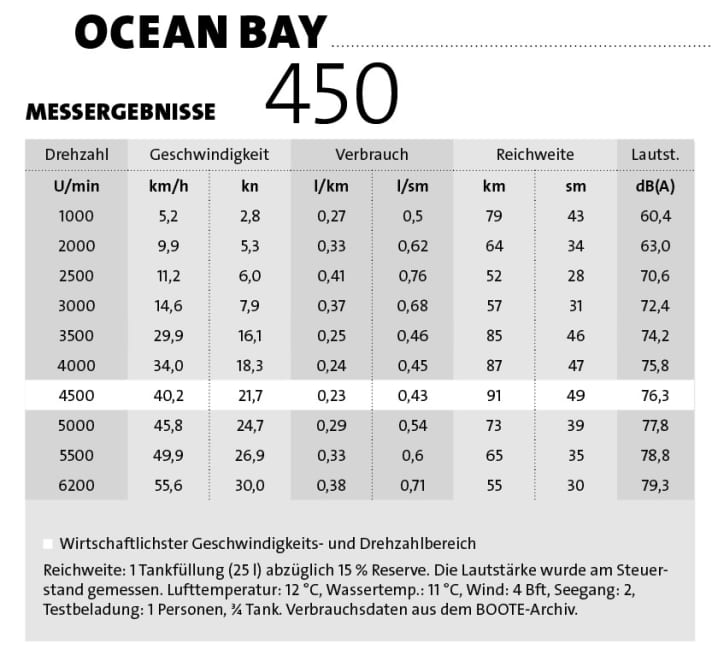
Due to the higher weight of the OceanBay, both boats have a similar driving performance, but are completely different in terms of driving behaviour. This is partly due to the flatter hull shape of the Pegazus and partly to the driver's seating position. On both boats, the driver sits right at the stern - but while on the Pegazus he sits in the rearmost right-hand corner of the cockpit next to the engine and brings the centre of gravity very far back, on the OceanBay the driver has the engine and the entire bathing platform a good metre behind him. A distance that makes a big difference when it comes to the swimming position of a boat that is only 4.5 metres long. In addition, the engine is perceived as significantly less disturbing at 79.3 dB compared to 85 dB at full load.

Due to the slight stern-heaviness when sailing alone, the engine must always be trimmed to the stern on the Pegazus at "traffic light start", because otherwise the bow rears up enormously and obscures the driver's view. It can only be raised to cruising trim at a good planing speed from around 20 knots. With the OceanBay MM-450, visibility is not impaired with or without trim. Once a good planing speed has been reached from around 3500 rpm, the wheel can be let go, as the boat is wonderfully stable on course with a little trim. Throttled down to a fast displacement speed between 1300 and 2500 rpm, the driving pleasure is dampened by strong vibrations of the perspex disc.
In rough water, the Pegazus mutates into a "flying boat" during fast wave crossings (from around 24 knots) and thus lives up to its name (that of the winged horse in Greek mythology). Even the five cm thick seat cushions provide little relief for the spine when the hull subsequently sinks hard. The OceanBay, on the other hand, rides the waves in a much more controlled and pleasant manner. It also proves its good-naturedness during fast manoeuvres. Even in cruising trim, tight turns up to 4200 rpm are possible without the propeller drawing air, and the slalom is possible up to 5000 rpm. With the trim down, all manoeuvres are completed without any problems. The Pegazus performs the manoeuvres much more sportily with more heel and only reaches its limits when making very tight starboard turns at full throttle. Otherwise, the boat's handling can be described as almost perfect. Harbour manoeuvres are a breeze with both boats thanks to very direct steering and tight turning circles.
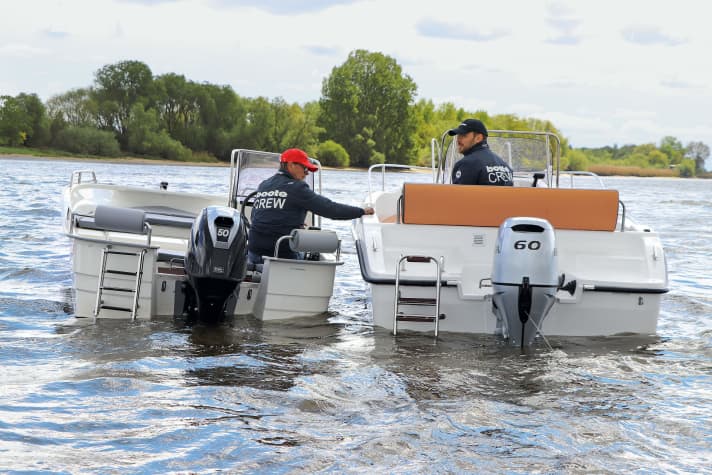
Security
The largest target group for open console boats are young families who go on short day trips. Safety is therefore an important issue. Not only that which is certified by the CE sticker anyway, but above all the perceived safety.
Both boats offer a feeling of security thanks to high side walls, an effective anti-slip structure on the cockpit floor and plenty of handholds. They are equally suitable for families on sheltered inland waters. The Pegazus is a little more fun to drive. In rough water, however, the boat can be a little rough, and if the trim or load is incorrect, the nose will rise higher than a beginner would expect, which requires quick reactions. In this case, sailing on board the OceanBay probably feels safer for both beginners and young families, as the boat is similarly fast but a little more good-natured.
This comparison test was published in BOOTE 08/2020. The magazine is now available at newsagents or directly from Delius Klasing Publishing House.

